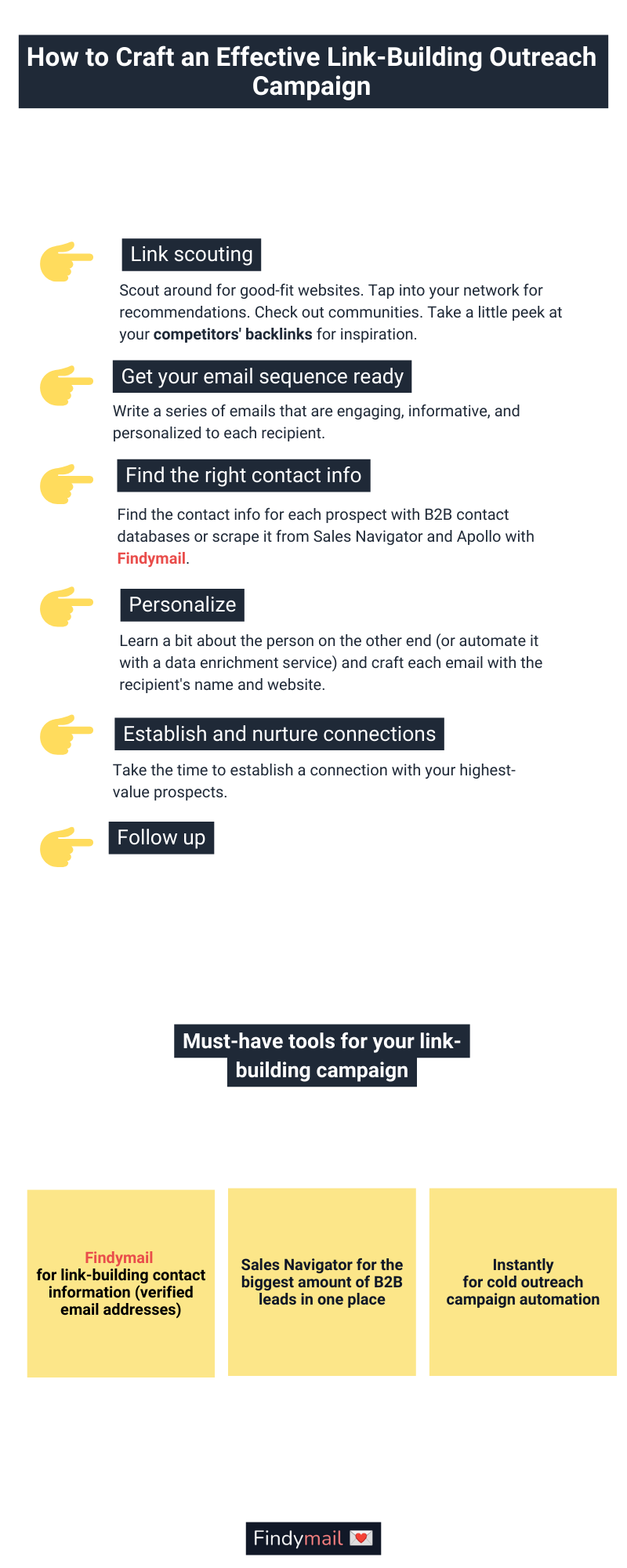If you’re like me, you don’t want to run a link-building campaign that gets nowhere. Trust me: I’ve been there (and beyond). But over the years, I’ve come up with a few tricks that can turn your outreach campaign into an actually profitable experience.
So, buckle up and get ready to learn how to craft a link-building outreach campaign that will leave your audience eager to link to your website. You’ll learn:
- Why link-building outreach campaigns often fail (and how to prevent making the same mistakes)
- The psychology behind outreach (including link-building)
- Specific suggestions like how to phrase subject lines
- Templates
- Tools
And more!
Let’s make your outreach process a breeze!
Why Your Link-Building Approach Probably Isn’t Working
The first thing we need to do is figure out why our link-building efforts aren’t getting the results we’re looking for. I’ve narrowed it down to 5 reasons link-building often fails.
1) Spray & Pray Methods
One of the biggest mistakes I see is people thinking they can send out the same generic email to as many people as possible, hoping that someone will take the bait. It might have worked in the late 90s and early 2000s, but you need to be more deliberate in your approach.
2) No Sequences in Your Link-Building Outreach
Another issue is the lack of drip sequences. You can’t be one and done. Send out multiple messages and master the art of the follow-up because people are busy, and emails can get lost in the shuffle sometimes.
3) Lack of Organization
Ever heard the saying, ”Victory Loves Preparation”? Without proper email tracking and organization skills, you may be wasting time sending emails to people who have already said no or who have already linked to similar content.
4) Not Warming Up Leads
Yes, I’m all about cold outreach, but sometimes a little warmup can go a long way to closing a deal. Sending cold link-building emails without prior interaction with the recipient can be a turnoff.
5) No Personalization
Finally, personalization is a big aspect some people don’t take the time to implement. Remember, your prospect wants to feel like you're reaching out to them specifically, not just copy-pasting the same email to everyone.
Source: SiegeMedia
So, if you're guilty of any of these offenses– well, the first step is acknowledgment. The second step is understanding the rules of the link-building game in 2023.
Psychology & The State of the Link-Building Market in 2024
Psychology is a powerful tool in our arsenal.
When you're reaching out to potential link prospects, you might encounter objections or hesitation as you would in regular sales calls and outreach. Don't take it personally– it's just human nature to be wary of unfamiliar requests, especially if we haven’t established a rapport with them.

If you want to overcome these objections, the best thing to do is offer them something of value:
- Maybe you have an interesting piece of content that would be a great fit for their website.
- You might have a unique perspective or expertise that they could benefit from.
You also need to be direct in what you want. Don't beat around the bush too much or try to trick your prospects into linking to your site. Instead, be upfront about your intentions and make it clear what you're asking for.
The Link-Building Market in 2024
The world of link-building outreach is constantly evolving, and it's important to keep up with the latest trends and changes. As we move through 2024 and beyond, it's clear that producing high-quality content is more important than ever for success.
Big Sites Charge for Backlinks
In today's market, you can expect reputable sites to charge for backlinks, and this trend is likely to continue. (Quality sites know their Domain Authority is strong, and they’re topical experts - so they know just how much they should charge to share their reputation with you.)
But You Can Strike up Free Partnerships to Win Links
Another thing to keep in mind about the current state of the market is the value of partnerships. By collaborating with other businesses or individuals in your industry, you can expand your reach and potentially get more backlinks to your site.
Plus, partnerships are often free between websites that have a similar Domain Authority to you and share content related to similar topics. These can be a bit harder to find, but they’re worth looking for.
For example, there are Facebook groups where bloggers exchange backlinks, so dig through them to find suitable websites.
Source: Delante
I Can’t Believe I Have to Say It, but…
Don’t pay for backlinks from shady link exchanges. I know you received those LinkedIn messages from “outreach specialists” who promise high-DA sites, but they’re shady, scammy, and spammy.
Getting a backlink from them won’t do much for your SEO. In fact, you could get a manual penalty.
Overall, the key to success in link-building outreach in 2024 is producing original, innovative content that others in your industry will want to link to naturally.

Think about it: writers and content managers are always on the lookout for fresh data they can use to back their arguments. Include:
- Perspectives
- Experiences
- Templates
- Statistics
… all of which you should gather from your own user base.
With that in mind, you’re ready to start building your link-building outreach campaign.
6 Steps for Creating a Winning Link-Building Outreach Campaign
OK, here’s a cheat sheet you can use to make crafting your perfect link-building campaign simpler. (Of course, you can adapt it to your needs, and I’ll provide some templates before I’m done with this guide.)
Step 1: Link Scouting
Time to play detective! Before you start reaching out, scout around for potential websites that might be a good fit for your content.

Tap into your network or any existing connections to ask for recommendations or related communities you can join.
Oh, and there’s nothing wrong with taking a little peek at your competitors' backlinks for some inspiration. I’ve done it plenty of times, so I’m definitely not going to judge you.
Step 2: Get Your Email Sequence Ready
Now it's time to get your email game on point. Write a series of emails that are engaging, informative, and personalized to each recipient:
- Start with a great subject line.
- Break the ice.
- Explain why they should care.

Remember, you could craft the perfect and most captivating sales pitch, but it’s moot if no one ever reads it. And don't forget to include a clear call-to-action so they know what you want them to do (e.g., Do you want a guest post? A backlink exchange? Have them update an outdated link?).
Step 3: Find the Right Contact Info
Get ready to put your sleuthing skills to work again. Find the right contact info for each prospect with B2B contact databases or scrape it from Sales Navigator and Apollo with Findymail.
(I’ll explain more about how it works in the Tools section.)
Step 4: Don't Forget Personalization
Nobody likes a generic email that could have been sent to anyone and their brother.
Take the time to learn a bit about the person on the other end (or automate it with a data enrichment service) and craft each email with the recipient's name and website, and show that you've done your research.
Step 5: Establish and Nurture the Connection
You don't want your outreach to feel like a cold, impersonal request– even if it is a “cold” outreach per se.
Take the time to establish a connection with your highest-value website prospects:
- Engage with their content on social media
- Comment on their blog posts
- Send them a friendly message every once in a while
Who knows, you might even end up making a new friend!
Step 6: Following Up on a Link-Building Email
Persistence pays off. Don't be afraid to follow up with a friendly email if you don't hear back right away. Just don't be too pushy.
To sum it all up, creating a winning link-building outreach campaign requires a bit of detective work, a personalized touch, and a friendly demeanor.
It's all about building relationships and establishing connections with your prospects. So put in the extra effort to make your outreach stand out.
With these steps in mind, you'll be well on your way to building better links and boosting your website's SEO.
Link-Building Outreach Campaign Templates and Examples
Initial Email Template for Link-Building Outreach
Subject: [Personalized] [Offer/Request]
Hi [First Name],
I hope things are well with you. My name is [Your Name], and I'm reaching out to you because I noticed that you're involved in [Their Industry/Website]. I was impressed with your work on [Specific Project/Article] and thought that [Your Website/Content] could be a valuable resource for your readers.
I'm writing to ask if you'd be interested in including a link to [Your Content/Website] in your next [Their Content Type] or if you have any other ideas for collaborating. I believe that this could be a mutually beneficial partnership and would love to discuss it further if you're interested.
Thank you for your time and consideration.
Best,
[Your Name]
Follow Up Email Template
Subject: [Personalized] Following Up on [Previous Email]
Hi there again [First Name],
I just wanted to follow up on my previous email and see if you had a chance to consider my proposal.
If you're interested in collaborating or have any questions, please let me know. I’m sure that my content gives a unique perspective on [Topic] that your audience will love because [Argumentation]. I'd be happy to discuss further and provide more information about [Your Content/Website].
Thank you for your time and consideration.
Best,
[Your Name]
Initial Email Example
Subject: Come on [Name], Increase Your Customers’ Sales with SalesBoost!
Hi [Name],
Hope things are going well for you. My name is [Your Name], and I work for [Your Company and What It Does - e.g., SalesBoost, a SaaS company that offers a sales automation tool]. I came across your website, and I was impressed by the content you've been putting out in the [Industry], particularly your recent article on [Article Topic].
I wanted to reach out to see if you would be interested in learning more about how [Your Company] could benefit your audience. We have great articles backed with data: [List the content], and our platform has helped businesses [Achieved Outcome - preferably Metrics], and we believe it could be a valuable addition to your article on [Article title].
If you're interested in learning more, [CTA like asking for meeting availability].
Best regards,
[Your Name]
Follow Up Email Example
Subject: RE: Come on [Name], Help Your Audience [Achieve Outcome] with Expert Insights!
Hello again [Name],
I wanted to follow up on my previous email regarding [Your Previous Email Topic]. I understand that you're likely very busy, but I wanted to make sure that you didn't miss my email, so your audience can [Achieve Outcome].
If you're available, I'd be happy to [link-building Pitch, e.g., send you a curated list of our content or prepare a guest post outline].
Please let me know if this is something you're interested in. If not, I understand and I won't follow up again.
Best regards,
[Your Name]
Must-Have Tools for Link-Building Outreach Campaigns
Of course, there are a ton of tools available to help you create winning link-building campaigns. Let’s take a look at some of my favorites!
Findymail for Link-Building Contact Info
Findymail is a game-changer when it comes to link-building outreach. I originally built it because it was hard to get accurate email address information. And don’t get me started on mass-exporting Sales Navigator or Apollo leads. Whew!
So today, Findymail is a user-friendly Chrome extension and API that can help you easily get verified emails at an affordable price. You can find them while browsing online:
… or automatically fetch verified emails for the leads you aggregated in Sales Nav or Apollo:
Instantly for Cold Outreach Automation
Instantly is a lifesaver for anyone looking to scale their link-building outreach campaign quickly. Plus, it integrates with Findymail!
Using AI, Instantly helps you:
- Find leads
- Set up sequences
- Figure out the best delivery time
And more!
With Instantly, you can take your outreach to the next level and get the results you're after in no time. It’s really a must-have for SEOs and sales professionals alike.
If you want to build out a suite of tools to help with your link-building outreach efforts, here are the 10 best cold outreach tools you should use.
Demandbase for Data Enrichment
My next tool is Demandbase. This AI-powered data enrichment service can help you automate the process of keeping your lead list up-to-date and ready to go.
With features like firmographics, intent data, technographics, and more, Demandbase provides detailed insights into your prospects, so you can prove you understand their business, and you think linking to your content is a great course of action.
Of course, this is one of many data enrichment tools, so check out my linked article to find one that might be better suited to your needs.
Warmup Inbox to Improve Your Deliverability
Next is Warmup Inbox– this bad boy uses a network of over 20,000 real inboxes to simulate the behavior of a regular inbox (“warm up your inbox”) so your emails are more likely to land in the right place instead of the Promotions tab.
It gradually increases your email volume over time, while also helping you follow best practices for email authentication and reputation management.
If you’re looking for other tools to help stay out of the spam folder, read my overview of the top 5 email warmup tools.
Link-Building Outreach Best Practices
Follow these best practices, and you’ll have a good time with link-building outreach.
Craft a Good Subject Line
Thought I forgot, eh? Subject lines play a critical role in getting a response in the first place. A good one is attention-grabbing, personalized, and clearly communicates the value of your email. Don’t be too sales-y or use clickbait tactics.
Here are some examples:
- Love your recent article on [topic], [name]!
- Are you still accepting guest posts for [blog name]?
- New [tool/product] that will boost your SEO
- How we [action] and increased our traffic by [percentage]
Find Unlinked Opportunities
Finding unlinked mentions in your content is a great way to identify potential link-building opportunities. For example, another website has mentioned your brand, but didn’t link back to your site. You can reach out to see if they can change that.
To find unlinked opportunities, you can use tools like Google Alerts, Ahrefs, or SEMrush.
Always Personalize Your Link-Building Outreach Messages
Do some digging on the person you're reaching out to and mention something specific about them or their work:
- Their role
- Their industry
- Specific content they’ve produced
Showing that you've put in the effort to get to know them will go a long way in building a connection.
Plus, you can automate the approach with the tools I mentioned above.
Source: Backlinko
Try Different Link-Building Techniques
- The Skyscraper technique. Produce content by mentioning everything your SERP competitors are + add a little extra.
- The Moving Man method. Find websites that linked to your competitors and have outdated articles. Create a fresher article and offer it to them.
- Broken link-building method. Find broken links on your target outreach websites and offer a suitable replacement.
- Use SparkToro to find influencers and trending topics. Then, reach out to them with a personalized pitch.
Final Thoughts on Link-Building
Link-building outreach is challenging. But with the right tools, strategies, and mindset, they can lead to amazing results. It's all about finding what works best for your business and audience!
Whether you're a seasoned link-building pro or just getting started, the key is to stay curious, stay creative, and always be willing to try new things.
Remember, link-building is not just about building links; it's about building relationships and adding value to your shared audience!







